Art & Exhibitions
In Bill Cunningham’s Photos, New York Wears Its Landmarks on Its Sleeve
How the photographer made a case for architectural preservation, beautifully.
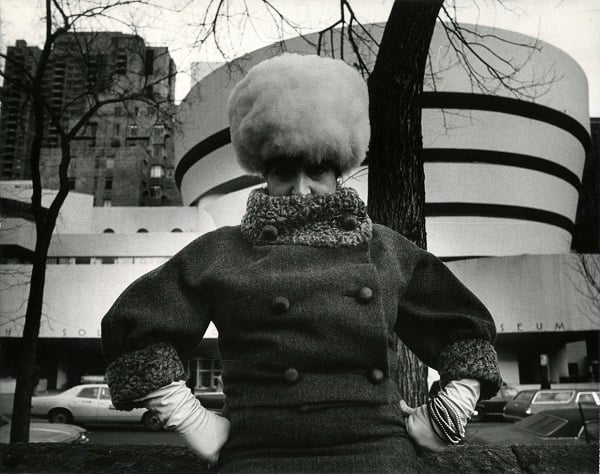
How the photographer made a case for architectural preservation, beautifully.

Daniella LaGaccia

Bill Cunningham is equally adept at capturing cotton and concrete, satin and steel. His photographs of New York City function as documents of sartorial and architectural history, cataloguing the city’s landscape over the last half-century with style and care.
A new exhibition at the New-York Historical Society (NYHS) focuses specifically on a series he did from 1968–72, capturing everything from graffiti-filled subway cars to Oldsmobiles parked in front of the Guggenheim—but with a touch of period costume dress-up.
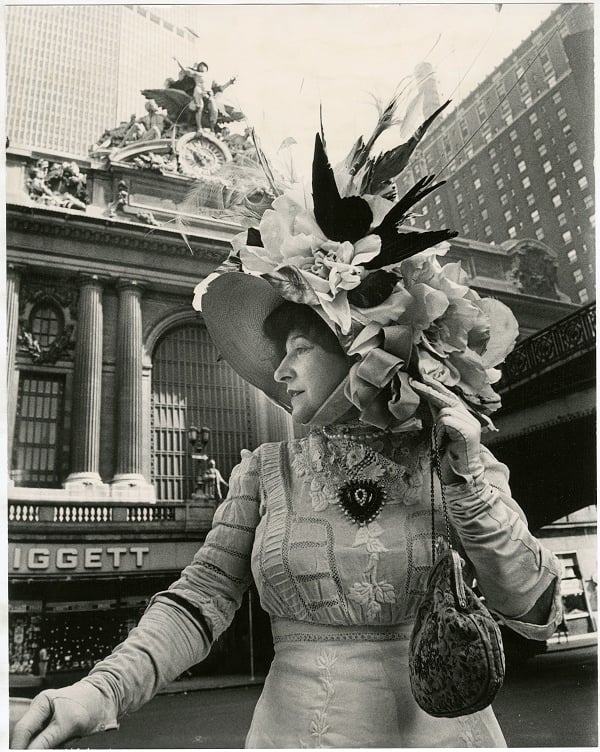
Bill Cunningham, Grand Central Terminal (built ca. 1903-1913), ca. 1968-1976.
Courtesy New-York Historical Society, Gift of Bill Cunningham.
“Bill Cunningham: Facades,” curated by the NYHS’s president of scholarly programs Valerie Paley, features photos taken by the beloved New York Times street and fashion photographer, who is now 85 years old. Most feature his good friend and fellow photographer Editta Sherman posing in front of Manhattan landmarks wearing clothing from the periods during which the buildings were erected.
“He’s almost like a social historian,” Paley said during an exhibition preview. “Facades,” she noted, is one of very few fashion-focused shows the NYHS has ever presented.
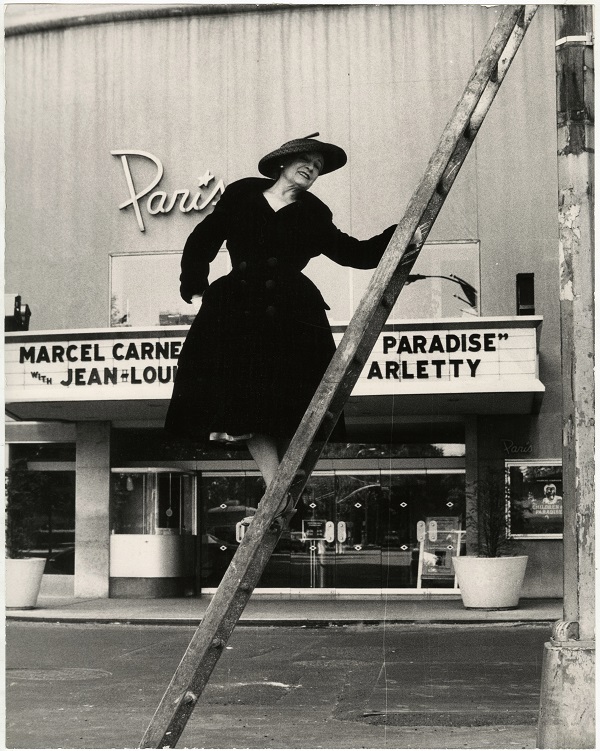
Bill Cunningham, Paris Theater (built 1947), ca. 1968-1976.
Courtesy New-York Historical Society, Gift of Bill Cunningham.
Cunningham’s photographs feature buildings ranging from the familiar—including City Hall, the Plaza Hotel, and St. Paul’s Chapel—to the more esoteric, like the Alwyn Court Apartments, Club 21, and the Abigail Adams Smith House. The images convey both a love for and enormous breadth of knowledge about New York.
The exhibition organizes Cunningham’s takes on city history and fashion by time period: 1766–1836 (tricorner hats); 1840–1875 (gloves and parasols); and 1940–1968 (mini-skirted models). Sometimes, Cunningham deliberately captured anachronisms in his frame. In a photograph titled 406-418 West 20th Street, for instance, air conditioning units stick out prominently from the windows of a nearly 200-year-old brownstone just above Sherman, who is wearing an 18th century gown.
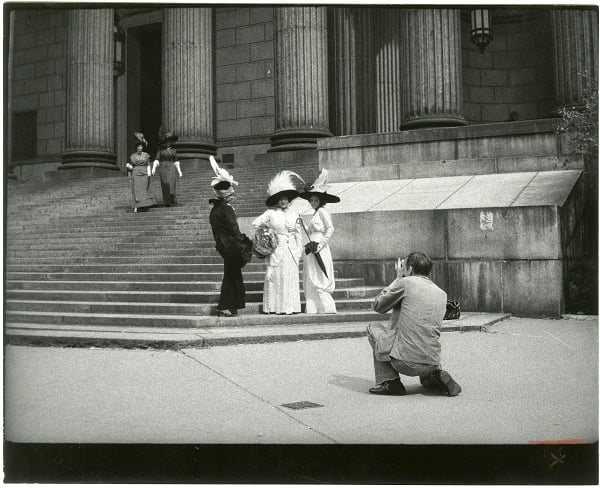
Unknown artist. Bill Cunningham Photographing Three Models at New York County Court House, ca.1968-76.
Courtesy New-York Historical Society, Gift of Bill Cunningham.
Cunningham, a noted hatter, paid close attention to the garments in relation to the buildings. He photographed Sherman in front of Grand Central Terminal with a dress and hat that deliberately complimented the sculptural architecture of the building. The garments Cunningham used were partly sourced from thrift shops and antique stores throughout the city. “He was very particular about the accessories he put with the costumes,” said Paley.
Sherman, the model in most of the photographs, passed away in November 2013 at the age of 101. Along with Cunningham, she was a longtime resident of Carnegie Hall, living and working out of her apartment atop the famed concert space from 1949 to 2010. Like Cunningham, she was also a prolific photographer, and shot, among many others, Andy Warhol, Leonard Bernstein, Leopold Stravinsky and Henry Fonda.
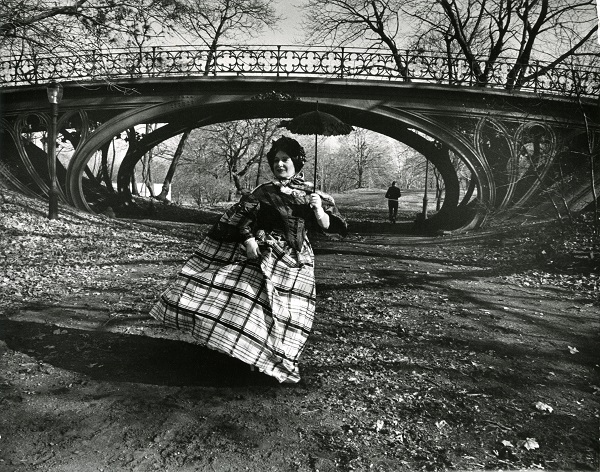
Bill Cunningham, Gothic bridge in Central Park (designed 1860), ca. 1968-1976.
Courtesy New-York Historical Society, Gift of Bill Cunningham.
The Historical society has about 80 photographs on display in the show. All of the photos are gelatin silver prints in black and white. “We put up what we had, we only have a small portion of them,” Paley said. The photographs were donated to the institution by Cunningham in 1976 but represent only a fraction of the nearly 1,800 he took during the project.
At the time Cunningham was shooting “Facades,” historical building preservation had become heavily politicized—especially after Penn Station was razed in 1963—and the new was quickly replacing the old. Now, nearly 50 years later, how are the buildings he shot faring?
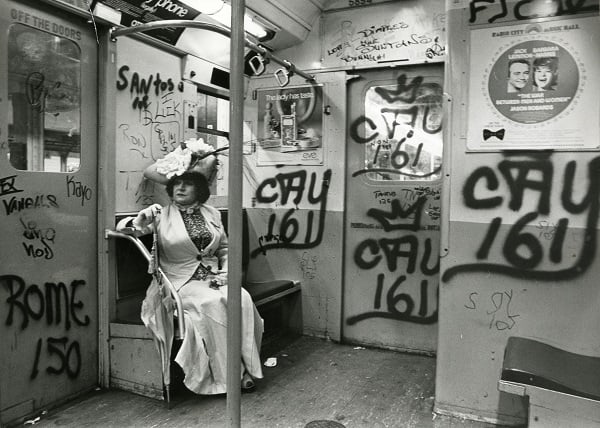
Bill Cunningham, Editta Sherman on the Train to the Brooklyn Botanic Garden, ca. 1972.
New-York Historical Society, Gift of Bill Cunningham.
“I’ve gone through all of them, and I believe that all are still here,” Paley said. But “some… were highly contested. Many of those [buildings] were not necessarily out of the cross-hairs of the wrecking ball.”
“Bill Cunningham: Facades” runs through June 15 at the New York Historical Society, with a free screening of the 2010 documentary Bill Cunningham New York on April 16 at 7:00 p.m.